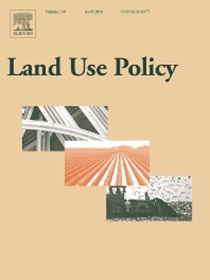Land cover changes in buffer zones and the effectiveness of this conservation strategy: Case study of Southeastern Brazil
IF 5.9
1区 社会学
Q1 ENVIRONMENTAL STUDIES
引用次数: 0
Abstract
Although buffer zones have been established around protected areas as an effective strategy to minimize human impacts on significant conservation areas, considerable challenges remain in managing these zones, including frequent disregard for their management rules. The objective of this study was to analyze the land cover changes that took place from 1985 to 2022 around 25 conservation units in São Paulo State (Brazil). The methodological process consists of two stages: (1) Identifying and analyzing land cover changes in the buffer zones and external zones adjacent to these zones; and (2) Evaluating the effectiveness of the buffer zones and comparison of the changes observed in buffer zones and external zones. The results demonstrated that land cover changes in the buffer zones and external zones generally behave similarly in the studied conservation units and are positively correlated, meaning they tend to move in the same direction. This behavior is counterintuitive to what was expected for the buffer zones. Greater São Paulo and its surroundings, as well as the central-eastern region of the state, showed a higher concentration of conservation units with a tendency for natural habitat loss in both zones (buffer and external zones). In contrast, regions such as the Vale do Ribeira and Paranapanema, as well as Pantaninho Paulista, showed a tendency for natural habitat gain in these zones. It is hoped that the information imparted by this study can be utilized by managers in the decision-making process, aiming for more targeted and successful management of protected areas and their surroundings.
缓冲区土地覆盖变化及其保护策略的有效性:以巴西东南部为例
虽然在保护区周围建立缓冲区是一种有效的策略,以尽量减少人类对重要保护区的影响,但在管理这些区域方面仍然存在相当大的挑战,包括经常无视其管理规则。本研究的目的是分析1985年至2022年巴西圣保罗州25个保护区的土地覆盖变化。方法过程包括两个阶段:(1)识别和分析缓冲区及其外围地带的土地覆盖变化;(2)评价缓冲区的有效性,比较缓冲区与外部缓冲区的变化。结果表明,在研究的保护单元中,缓冲带和外部带的土地覆盖变化总体上表现相似,呈正相关关系,即它们倾向于向同一方向移动。这种行为违反了对缓冲区的预期。大圣保罗州及其周边地区,以及该州的中东部地区,显示出较高的保护单位集中度,两个区域(缓冲区和外部区域)的自然栖息地都有丧失的趋势。相比之下,像里贝拉河谷和帕拉纳帕内玛以及潘塔尼尼奥保利斯塔这样的地区,在这些地区显示出自然栖息地增加的趋势。希望本研究提供的信息能被管理者在决策过程中加以利用,使保护区及其周边环境的管理更加有针对性和成功。
本文章由计算机程序翻译,如有差异,请以英文原文为准。
求助全文
约1分钟内获得全文
求助全文
来源期刊

Land Use Policy
ENVIRONMENTAL STUDIES-
CiteScore
13.70
自引率
8.50%
发文量
553
期刊介绍:
Land Use Policy is an international and interdisciplinary journal concerned with the social, economic, political, legal, physical and planning aspects of urban and rural land use.
Land Use Policy examines issues in geography, agriculture, forestry, irrigation, environmental conservation, housing, urban development and transport in both developed and developing countries through major refereed articles and shorter viewpoint pieces.
 求助内容:
求助内容: 应助结果提醒方式:
应助结果提醒方式:


